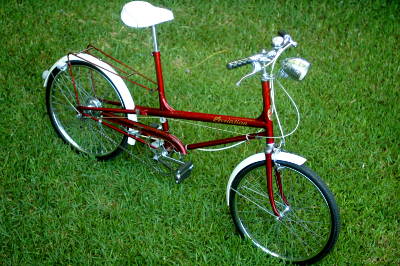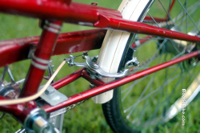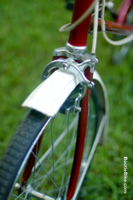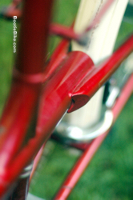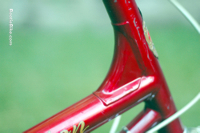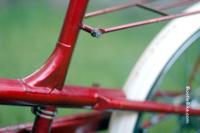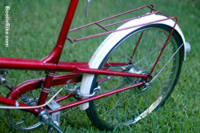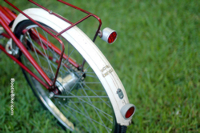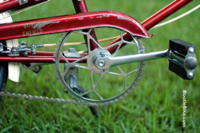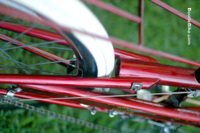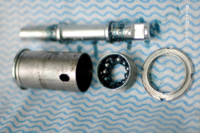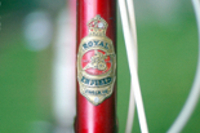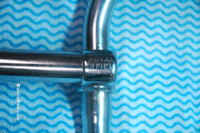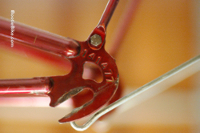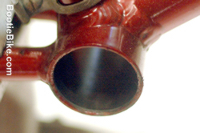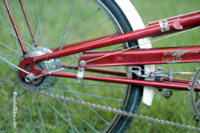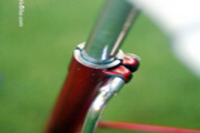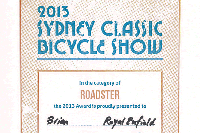1965 Royal Enfield Revelation
Small-wheeling's 'Third Way'
Welcome to today's lecture, this time on the Royal Enfield Revelation from 1965. The Revelation was introduced to the British market to compete with the wildly successful Moulton, with its tiny 16" wheels. 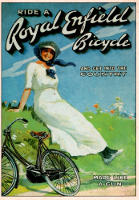 However, as other manufacturers were introducing models with similar-sized or even smaller wheels, Royal Enfield went the other way and opted for wheels that were much larger.
However, as other manufacturers were introducing models with similar-sized or even smaller wheels, Royal Enfield went the other way and opted for wheels that were much larger.
Why would they do that?
Well, it's all to do with overcoming the bumpy ride that comes with small wheels. Alex Moulton achieved that by equipping his bike with suspension, and Raleigh smoothed the ride of its RSW by going 'primitive', with soft, inefficient balloon tyres. Royal Enfield chose the The Third Way – like Dawes with its Kingpin the year before, they simply chose not-so-small wheels. Not big, like traditional bikes, but in-between, in this case 20”, or 451 ETRTO.
It was a compromise, but a pretty good one, as 20" wheels went on to become the standard for 'shopper' bikes. So what you see here is one of the original 20" shoppers – a progenitor of the many, good and bad, that conveyed the impoverished, the terminally practical and others with no shame during the car-crazed 70s and 80s. The difference is that at the time this bike was made – in the mid-1960s – the few 'twentys' around were not humble shopper bikes – rather they were The Bikes Of The Future.
This model bike of the future was very 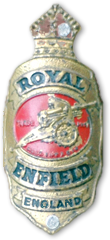 attractive, practical and pleasant to ride, so it deserved to succeed. Sadly, Royal Enfield was already failing when it introduced the Revelation, and it was destined to be their last new bicycle. No-one seems to know how many were made, but, whatever the number, the Revelation is well known for being rare.
attractive, practical and pleasant to ride, so it deserved to succeed. Sadly, Royal Enfield was already failing when it introduced the Revelation, and it was destined to be their last new bicycle. No-one seems to know how many were made, but, whatever the number, the Revelation is well known for being rare.
The Royal Enfield company was long established, having its origins in 1851 as a manufacturer of needles under one George Townsend. After Townsend's death his son, also George, began selling cycle parts to the trade before himself making complete bicycles. A takeover in November 1891 brought a new name: 'The Eadie Manufacturing Company Ltd'. That name didn’t last long, as a contract to supply precision parts to the 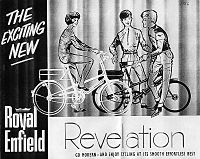 Enfield Royal Small Arms Factory brought about another change, this time to ‘Enfield’, and inspiring that most memorable of mottos: ‘Made like a gun’.
Enfield Royal Small Arms Factory brought about another change, this time to ‘Enfield’, and inspiring that most memorable of mottos: ‘Made like a gun’.
From there it only took a stern nod from the right direction to create the grandest name in bicycles: ‘Royal Enfield’. Motorcycles joined the product line in 1901 and the company established itself in that market as well.
However, by the 1960s the market for two wheelers of any kind had shrunk and the company was suffering. Bicycle production ceased in early 1967 with the closure of the Redditch factory, but motorcycle production lingered for a few years at Dr No's secret underground lair an underground factory at Westwood, Wiltshire that the company had used for producing arms during WWII. (History thanks to Burton Bike Bits)
Futuristic design
The Revelation may have been too little too late, but who can blame Royal Enfield for trying? The Moulton and the RSW had been selling up a storm, so it was only natural for Royal Enfield to follow suit. Long time company man Vic Bott (thanks Hadland's Blog) was responsible for the design, and it was truly original. Unlike the Moulton, RSW or Kingpin, it was not based on a single main tube, but rather what I think looks like a 'compressed', version of a conventional diamond frame with tall, freestanding steering and seat tubes that spell out a kind of Moulton-ish 'lazy F'. Well, sort of.
but rather what I think looks like a 'compressed', version of a conventional diamond frame with tall, freestanding steering and seat tubes that spell out a kind of Moulton-ish 'lazy F'. Well, sort of.
Distinctive details include that much-needed frame gusseting and the 'seat stays' affixed to the side of the large-diameter top tube. A sign of the times was the decision to have the end of each front fork pressed and slotted instead of using proper forkends (a separate piece of steel brazed in each fork end). Mind you, it still had the very trad 40 spokes on the rear wheel and 32 up front (there were 28 at each end of a Moulton or RSW). An easily missed detail is the Royal Enfield lettering faintly etched on the chrome of the handlebar stem. Finding this was quite a surprise when cleaning off the grime of ages.
Revelations came fitted with a three speed Sturmey Archer hub (in this example an AG) with a trigger shifter. The shape of the handlebars suits the Sturmey trigger very well, so this one is easily within finger range and convenient to use.
No Moulton rival would be complete without a built-in rear rack, and the Revelation rack is a classic. Beautifully realised, it is very fine, so much so it almost disappears, yet very sturdy. I like how the slope of the vertical supports echoes that of the seat and steer tubes. The rack on this bike lately supported a decrepit two-tone burgundy/white vinyl shopper bag. 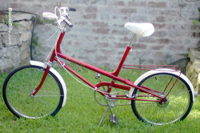 I'm hoping to find a suitable replacement, and while I'm dreaming, a rare front rack as well. But I'm not holding my breath.
I'm hoping to find a suitable replacement, and while I'm dreaming, a rare front rack as well. But I'm not holding my breath.
Unusual bottom bracket
An unusual feature of the Revelation is its 'Bayliss Wiley unit bottom bracket'. This is a separate, self contained unit (a bit like a modern sealed bottom bracket) that fits into a plain, slightly larger-than-usual bottom bracket shell in the frame. It comprises a steel cylinder with a slightly modified bearing cup at each end. The cylinder is held in the frame – perhaps not very well – by the bearing cups. This type of bottom bracket was introduced in the mid-1940s and fitted to various English lightweights through the 1950s and, as we can see, a mid-sixties small wheeler as well. How did it end up on the Revelation? Maybe the struggling Royal Enfield couldn't resist a job lot.
The unit bottom bracket was never popular and it had a  reputation for coming loose due to a lack of positive location. This tallies with my own experience. Within a few weeks of commuter 'testing' of my newly rebuilt revelation I could discern some strange movement through the cranks, and sure enough
reputation for coming loose due to a lack of positive location. This tallies with my own experience. Within a few weeks of commuter 'testing' of my newly rebuilt revelation I could discern some strange movement through the cranks, and sure enough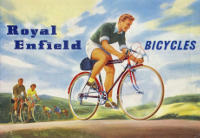 the bottom bracket lock ring had undone itself and the bottom bracket was free to move laterally some several millimetres. According to davepalk the solution is to fix the unit in the frame, using an adhesive and/or a screw. A second opinion (thanks to vintagebikeshed) is that it is simply not tightened up properly on the lockring side.
the bottom bracket lock ring had undone itself and the bottom bracket was free to move laterally some several millimetres. According to davepalk the solution is to fix the unit in the frame, using an adhesive and/or a screw. A second opinion (thanks to vintagebikeshed) is that it is simply not tightened up properly on the lockring side.
Another feature of dubious value, albeit not so unusual, is the overly high standard gearing, which I calculated at (thanks Sheldon) over 90 gear inches in top. A larger rear sprocket has made it much more pleasant to ride.
And pleasant it is. Solid and comfortable, it's unremarkable to ride, steady as she goes. The handlebars are surprisingly low – not sporty low, yet far from 'sit up and beg', and the riding position, like all else about the bike, is easy and relaxed. It wears repro Raleigh Records at the recommended 55 psi.
This example
As with unfashionable bikes everywhere, this particular bike (frame number 141477), when its time came, was no doubt cast off into a shed 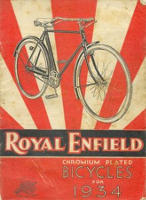 or cellar or somewhere to rot. But some love lingered; the rust I saw in the photos before I bought it turned out to be dried up oil, so most of the shiny bits remain so. It has its quota of paint scratches though. I've tried to keep it as original as possible – too bad the original seat and shopper bag were perished.
or cellar or somewhere to rot. But some love lingered; the rust I saw in the photos before I bought it turned out to be dried up oil, so most of the shiny bits remain so. It has its quota of paint scratches though. I've tried to keep it as original as possible – too bad the original seat and shopper bag were perished.
The chain guard, which bears the trad Royal Enfield script, also bears some nasty scratch marks resulting from contact with the drive side crank. The culprit is the little bracket that attaches the chainguard to the chainstay. A bit of rotational movement and voila! – the micron's clearance between chainguard and crank vanishes, leaving a nice scrape as a friendly reminder. A bit of rubber under the chainstay bracket now helps it stay put.
I hope you've enjoyed reading about Royal Enfield's attempt to tap into the success of the Moulton and the other small wheelers. A nice design, but somehow it ticks all the boxes without managing to inspire. Maybe it's too ordinary – almost normal. Perhaps it is in the company of the Bootie or a Trusty Spacemaster, but it endears itself in other ways. For example, being famously rare, rather than obscurely rare, the Revelation enjoys a celebrity status forever denied those forgotten heroes. And it’s a very attractive, practical mount that’s even pleasant to ride. You could do a lot worse than that!

